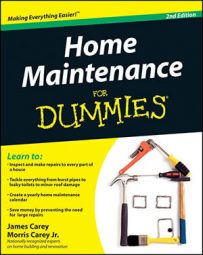A painted deck or fence can be beautiful, but painting can also be a real problem. Unlike wood siding, wood in decks, handrails, fences, retaining walls, and other complex structures expose several surfaces of each piece of wood to the weather. Some of the surfaces (such as the area between a fence rail and a fence board) are inaccessible and can’t be protected, which makes it difficult to achieve a complete waterproof membrane, even if you caulk.
Partially painted pieces of wood create a real problem. Even if the unpainted side doesn’t get wet directly, exposed wood can absorb moisture from vapors rising from beneath. After the exposed wood absorbs moisture, the painted surface on that same piece of wood can become riddled with bubbles, splits, chips, and peeling paint. And when the painted surface has been compromised, it can no longer fully protect the wood — in fact, the damaged surface becomes a contributor to further moisture attack.
Don’t paint unless you can cover all six sides of every piece of wood. In situations where pieces of wood are sandwiched together, and the joined surfaces can’t be painted, then the pieces should be joined as one by thoroughly caulking all connecting joints. If all sides can’t be reached, you’ll get the best protection with an oil or oil-stain finish — not with paint.
Because of the chipping, bubbling, and splitting normally associated with painted decks and handrails, we’re reluctant to suggest painting. However, if you do decide to paint, do the following:
Make sure that the surface is thoroughly clean and that the wood is dry.
Go to extremes to get the wood clean: pressure-washing, sanding, and detergent scrubbing.
Remove all loose nails and replace them with the next larger size.
The larger nail will provide a like-new grip, holding loosened wood firmly in place. Use a hammer and nail punch to countersink all nails. Fill the resultant nail hole with a high-quality, exterior-grade putty.
Use a hinge pin (removed from a door hinge) as an oversized nail set — it’s much easier for a novice to use than a common skinny tipped nail punch.
Fill all other holes with a high-quality, exterior-grade putty.
While you’re applying the putty, be sure to remove all excess putty to keep sanding to a minimum.
Apply a high-quality polyurethane caulk at all joints.
Prime all bare areas and puttied spots with a high-quality, oil-based primer.
Finish decks with a high-grade, oil-based finish. Handrails can be finished with a good-quality acrylic paint.
Never paint a wood surface that has previously been oiled. The paint won’t stick, and you’ll have a mess on your hands forever. After wood is oiled or oil stained, even the most minute spots of leftover paint show up like a headlight on Lover’s Lane. If you insist on painting an oiled surface (or on oiling a painted surface), you must first take the time to use a paint remover followed by thoroughly sanding the wood.

